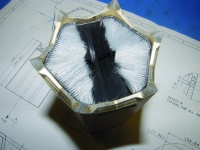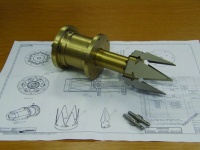
For space science and engineering, the coming decade is all about sample return. While previous planetary exploration missions have concentrated on what can be achieved with sensors on board spacecraft and sending back data and images, what the scientists really want is the materials themselves: chunks of rock and dust from other planets that they can study at their leisure with the full panoply of instruments at their disposal on Earth.
This, of course, creates a challenge for the engineers who have to find a way to comply with the scientists’ wishes. How do you bring something back from where no one has gone before?
EADS Astrium’s engineering team has been working on this problem in an attempt to figure out how to take samples of regolith – surface material – from an asteroid. Anticipating a proposed mission out to the asteroid belt between Mars and Jupiter, the team has tried to find a way to grab, scrape or gouge material from the surface.
There are several reasons for studying asteroids, mission systems engineer Lisa Peacocke told The Engineer. ’Asteroids are very old and they haven’t changed since they were formed,’ she said. ’They’re like a time capsule of what the solar system was like before the planets formed – especially in the asteroid belt, which should have formed into a planet but couldn’t because of the effect of the gravity of Jupiter. Looking at them gives us insights into the history of the solar system that we can’t get by looking at planets or the moon because they’ve changed so much over time.’
As well as the science aspects, an asteroid sample-return mission is an important stepping stone on the way to the big goal for planetary exploration in the next two decades – bringing material from Mars back to Earth. Asteroid study allows the techniques of sampling, storage and return to be tested with smaller, lower-cost spacecraft than the large rovers that will be sent to the Red Planet over the next 10 years, and the teams at ESA, NASA and the other space agencies taking part in the planned collaborative Mars missions are watching, and working with, the asteroid sample teams.
The EADS Astrium team started its work as part of a proposed mission called Marco Polo, which would have been a collaboration between ESA and the Japanese space agency JAXA. This called for a sampling mechanism that could obtain a sample weighing at least 40g, work within five seconds of landing on the asteroid, and operate up to three times. The sample had to contain particle sizes from microns up to 40mm, and it had to be obtained autonomously, with minimal control.
Although ESA decided not to continue Marco Polo, asteroid sampling is still high on the agenda for the agency and its fellow space organisations. ’There are a lot of proposed projects and they all have similar requirements, so we decided to keep on with this development,’ Peacocke said.
The requirement for autonomous operation led the team to look for simple mechanical devices and a series of brainstorming sessions led to a shortlist of 20 ideas. ’We started by getting about 20 people together from all levels, just to come up with ideas,’ Peacocke said. ’We didn’t want to be constrained by anything that had been done before – we were really thinking of anything that could work.’
The concepts ranged from simple shovels to powered bucket conveyors, taking in dustpan-and-brush combinations, inverted umbrellas, rotating wineglass-shaped drums, sticky pads, and something like a mutant carpet sweeper. ’Then we did a trade-off analysis, giving each idea a series of scores against things such as complexity, cost and feasibility,’ Peacocke said. Unpowered designs were preferred against powered ones, with simplicity – both of construction and of operation – and low parts count being preferable.
Three designs emerged from this process, all of which would work by being pushed into the surface by a spring: a device with a series of petals that would deflect inwards as it was driven into the surface, scraping a sample of rock into its centre; a pair of buckets that would be pushed together as they scraped the surface; and a punch lined with bristles that would capture fragments of material it withdrew from the asteroid. ’We thought that three was still too many, so we combined the petals and the bucket together into a system called a petal-punch hybrid,’ Peacocke said. This places the petal inner inside a cylindrical outer section that tapers at the bottom end to force the petals to converge as they are driven downwards.
The next stage was to test the devices, which required a simulated asteroid surface. The project is aiming at a variety of asteroid known as C-type, which is made from carbonaceous material. ’These are very old asteroids and their material might contain gas pockets from the very earliest stages of the solar system,’ Peacocke said. C-type asteroids are believed to be quite soft and crumbly structures made from porous particles, and a team from the Open University developed a material to act as a regolith analogue.

The test equipment for the trial consisted of a spring-loaded mechanism equipped with a vibrating motor. ’It was quite difficult to push the devices into the material by hand and we noticed that people tended to twist or vibrate it to get it to penetrate,’ Peacocke said. ’That led us to vibrate the test pieces, which worked really well. We also found that making the sampling device hexagonal worked really well, especially with the bristled punch – the corners became pointy shapes, which were really effective at penetrating the surface.’
For a real mission, the sampling devices would almost certainly be made from lightweight titanium, but for this early stage work the two test pieces were made from aluminium, apart from the petals themselves on the petal-punch hybrid. ’We made those from titanium because we wanted to be sure that the design would close properly with the material it would be made from,’ Peacocke said. The bristled punch used two different types of nylon bristle, soft enough to deflect along their entire length and packed densely inside the punch section to trap the maximum amount of material.
Both systems gave good results, picking up the required amount of material, according to Peacocke. ’We found that the petals on the petal punch didn’t close completely but that didn’t matter; it still picked up plenty of materials even when it was only partially closed,’ she said. The bristled punch proved very successful and it appears that tuning the length, thickness and stiffness of the bristles can make it more efficient for different sizes of particle. ’We’re thinking about a version with a range of bristle sizes,’ Peacocke added.
The team is continuing to work on the devices while new mission profiles are being devised. ’We’re talking to NASA, which is looking at an asteroid mission at the moment, and also with the Mars teams about the possibility of one of the designs going onto a rover,’ Peacocke said. ’There’s still a lot of possibilities for this.’
Scratching the surface
Dust taken from the Itokawa asteroid may whet appetites for further missionsThe first ever samples from an asteroid may have returned to Earth last month in a tiny capsule from the Japanese spacecraft Hayabusa, which visited the asteroid Itokawa in 2005. The capsule, which landed in the Australian Outback after its mothership burned up on re-entry, is currently being studied by JAXA in Tokyo.
Itokawa is an S-type asteroid, meaning it is composed of stony silica-based material, some 300,000,000km from Earth. Some space scientists have described it, unflatteringly, as a rubble pile, but nonetheless it’s one of only two asteroids that have been studied closely enough to reveal details of its surface.
Hayabusa’s sampling method was relatively crude: the craft landed on the asteroid’s surface briefly and fired a ball bearing into its surface, kicking up a small amount of dust. Some of this may have entered the funnel-shaped opening of the sample chamber. JAXA announced last week that the sample did indeed contain dust; however, it hasn’t yet confirmed that this came from Itokawa. There is some speculation that it could have entered the sample chamber when the craft was launched.
The sample is very small – only a few milligrammes – but Lisa Peacocke thinks that it will whet scientists’ appetite and make a further mission more likely. She said: ’Once they’ve got their hands on this material, they’re going to want more; and with the mission we’re aiming for looking at a different type of asteroid, they’ll want the variety of material as well.’




Glasgow trial explores AR cues for autonomous road safety
They've ploughed into a few vulnerable road users in the past. Making that less likely will make it spectacularly easy to stop the traffic for...